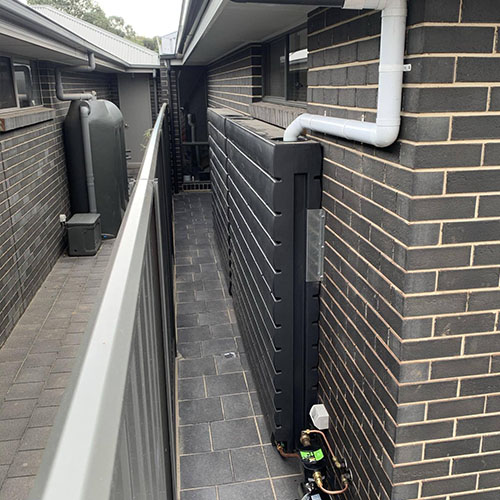Exactly How Slimline Water Tanks Boost Your Home's Water Effectiveness
Exactly How Slimline Water Tanks Boost Your Home's Water Effectiveness
Blog Article
Exploring the Numerous Uses of Rain Containers for Residential and Commercial Features
As the international concentrate on sustainable living practices remains to heighten, the use of rain tanks in both property and commercial settings has become a significant option. These tanks offer a reservoir for rainwater harvesting, providing a myriad of prospective applications that extend much beyond mere storage space. From irrigation to commode flushing and landscaping, the adaptability of rain containers is huge. Moreover, their combination into business homes opens a world of possibilities for ecologically conscious businesses. The diverse uses of rainwater containers offer a compelling case for their fostering, not just as a sensible water-saving action yet likewise as a testimony to accountable resource management.
Advantages of Making Use Of Rain Storage Tanks
Making use of rain containers offers countless advantages for both homes and neighborhoods in regards to water preservation and sustainability. One of the vital benefits of using rain storage tanks is the considerable decrease in reliance on keys supply of water - Slimline water tanks. By recording and saving rain for later usage, individuals and neighborhoods can reduce their need for treated water, inevitably reducing the concern on water therapy facilities and reducing energy consumption related to water transport and treatment
In addition, rain gathering through storage tanks offers a trustworthy different water source during times of water restrictions or scarcities. This kept rain can be made use of for different non-potable purposes such as watering, flushing bathrooms, and washing garments, lowering the stress on standard water sources. In addition, using rain containers can cause set you back financial savings for both households and areas by lowering water bills and reducing the demand for pricey infrastructure growths to meet expanding water demands.
Fundamentally, the usage of rainwater storage tanks provides a sustainable and eco-friendly approach to water monitoring, profiting both individual users and the wider community in terms of water preservation, cost-efficiency, and strength.
Rainwater Storage Tank Usage in Watering
Offered the advantages of rain tanks in saving water resources and lowering dependence on keys water, a significant application hinges on making use of stored rain for watering purposes - Slimline water tanks. Rainwater collecting systems can properly gather and store rain, offering a sustainable water source for watering yards, yards, and agricultural areas. By making use of rainwater for irrigation, residential property owners can minimize their dependence on cured water resources, bring about cost savings and ecological benefits

One of the primary benefits of utilizing rainwater for watering is its purity. Rain is normally soft and free from the chemicals and additives typically found in keys water, making it ideal for beneficial plants without the threat of unsafe effects. Furthermore, rainwater goes to ambient temperature level, which can benefit plant growth by staying clear of temperature level shocks that can occur with chilly mains water.
Rain Tanks for Commode Flushing

Executing rain containers for commode flushing is a cost-effective and ecologically pleasant method that can be quickly integrated right into both household and commercial residential or commercial properties. The stored rain can be used to flush toilets by linking the tank to the existing plumbing system. site web This simple yet reliable solution can significantly reduce water usage in a building, specifically in areas where water deficiency is a worry.

Integrating Rainwater Containers in Landscaping
These storage tanks can capture and keep rainwater overflow from roofings, which can after that be used for sprinkling gardens, grass, and plants. By making use of rainwater for watering functions, property proprietors can decrease their reliance on local water sources, leading to set you back financial savings and conservation of precious water sources.
Along with giving a lasting water source for landscaping demands, rain containers can also assist in handling stormwater runoff. By catching rainwater that would otherwise flow right into storm drains, these storage tanks can alleviate erosion, reduce flooding dangers, and avoid air pollution of all-natural water bodies. Incorporating rainwater containers in landscape design can add to the total visual appeal of the residential property, showcasing a dedication to environmental stewardship.
Industrial Applications of Rain Storage Tanks
Using rainwater tanks in commercial setups offers a lasting option for water administration and conservation, benefiting companies and the atmosphere alike. Business applications of rainwater tanks are diverse and increasingly popular because of the expense savings and ecological advantages they give. One key industrial usage is for watering objectives, where gathered rainwater can be made use of to water landscaping, yards, and farming areas bordering industrial homes. This can cause significant decreases in water costs and dependence on municipal water sources.
Furthermore, rainwater collected in containers can be dealt with and used for non-potable purposes within commercial residential or commercial properties, such as flushing toilets, cleaning, and cooling down systems. Generally, the unification of rainwater storage tanks in industrial settings presents a sensible and environmentally liable strategy to water management.
Conclusion
From irrigation to commode flushing and landscape design, the use of rainwater tanks can aid conserve water sources and reduce water costs. Overall, the convenience blog here and sustainability of rain tanks make them a valuable financial investment for any property proprietor looking to boost water effectiveness.
Report this page